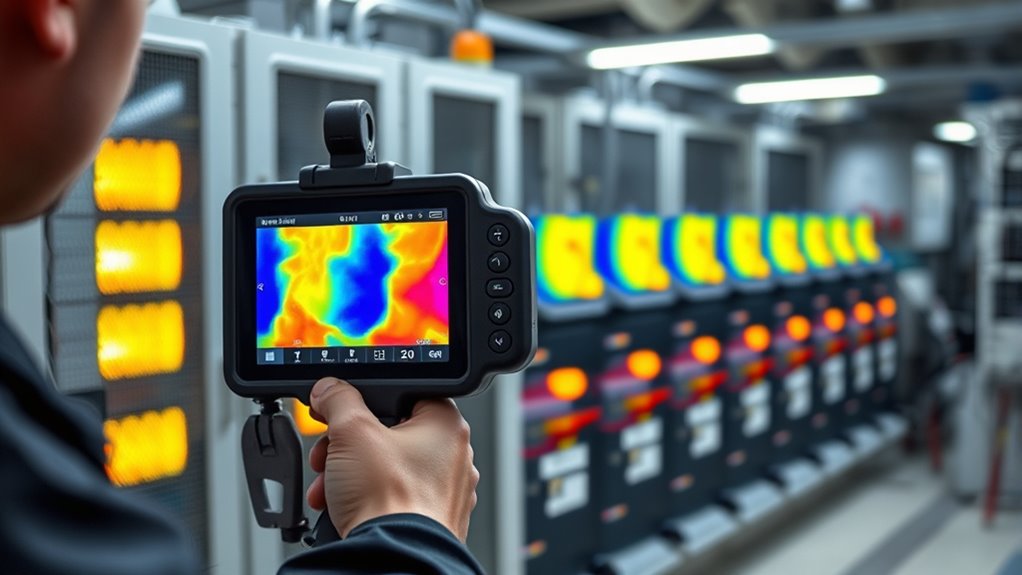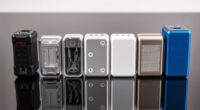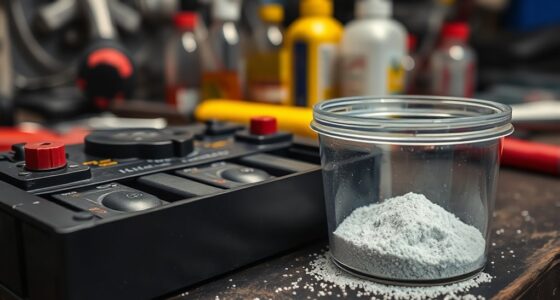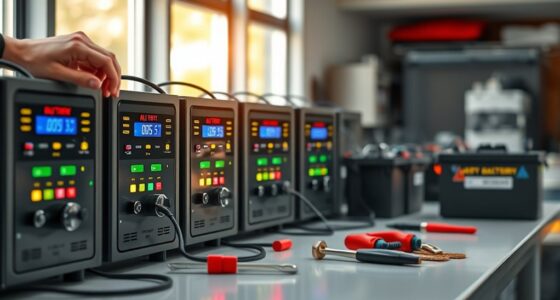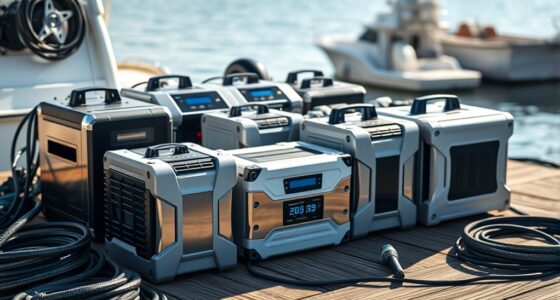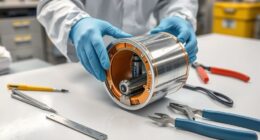If you’re looking for the best thermal cameras for battery inspection in 2025, I recommend tools with high thermal resolution, quick detection, and durable designs. Devices like the ERICKHILL ETI-01, TOPDON TC004, and FLIR C5 offer detailed thermal imaging, real-time alerts, and portability for pinpointing battery hotspots before failures occur. These models balance accuracy and usability, helping you stay ahead of issues. Keep exploring further, and you’ll discover which camera fits your needs best.
Key Takeaways
- High IR resolution (e.g., 512×384) ensures detailed thermal imaging for early battery fault detection.
- Features like emissivity adjustment and temperature alarms aid precise monitoring of battery health.
- Compact, portable designs with long battery life support quick, on-the-go inspections in various environments.
- Advanced sensors with thermal sensitivity below 40mk detect minor temperature variations indicating potential issues.
- Connectivity options such as Wi-Fi and app integration allow real-time data sharing and proactive maintenance planning.
ERICKHILL ETI-01 Thermal Camera with Infrared Thermometer
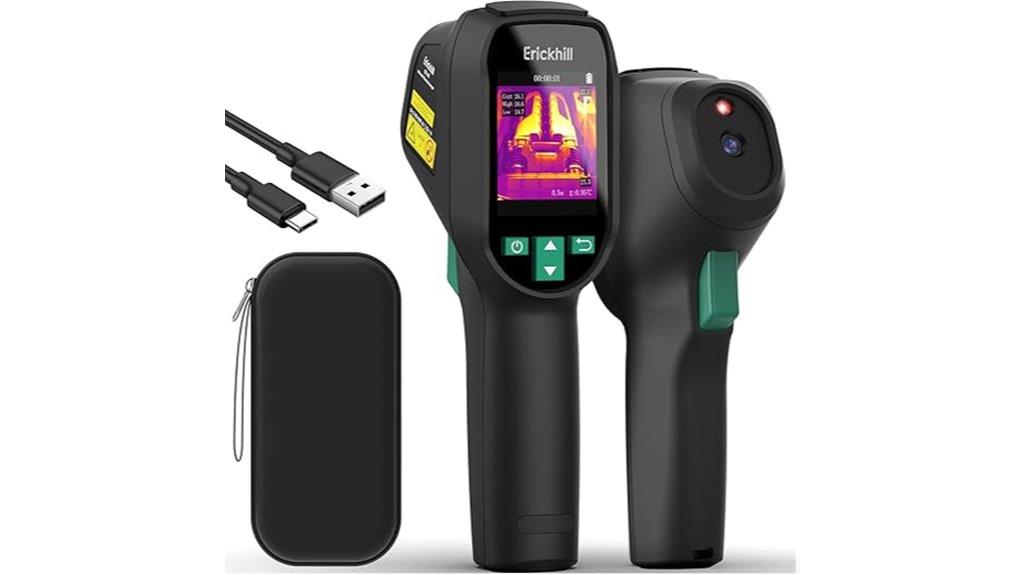
If you’re looking for a reliable thermal camera that offers professional-grade accuracy, the ERICKHILL ETI-01 is an excellent choice, especially for those inspecting electrical systems or mechanical components. It features Auto-Hot/Cold Spot Tracking, multiple color palettes, and over 30,000 radiometric images for detailed analysis. With a detection range from -20°C to 550°C, it helps identify issues like electrical hotspots, leaks, and insulation gaps early. Its high-resolution SuperIR technology delivers precise images, while the intuitive interface and laser pointer make targeting easy. Compact and portable, it supports long battery life, making it ideal for on-the-go inspections and preventing costly failures.
Best For: homeowners, electricians, and contractors seeking professional-grade thermal imaging for diagnosing electrical, mechanical, and insulation issues quickly and accurately.
Pros:
- High-resolution SuperIR technology with over 30,000 radiometric images for detailed analysis
- User-friendly interface with intuitive controls and laser pointer for precise targeting
- Long-lasting rechargeable battery supports up to 8 hours of continuous use, ideal for on-the-go inspections
Cons:
- Higher price point may be a consideration for casual or infrequent users
- Non-user-replaceable battery requires charging via USB-C and limits battery swapping flexibility
- Slightly bulky design compared to compact models, which might affect portability for some users
TOPDON TC004 Thermal Imaging Camera
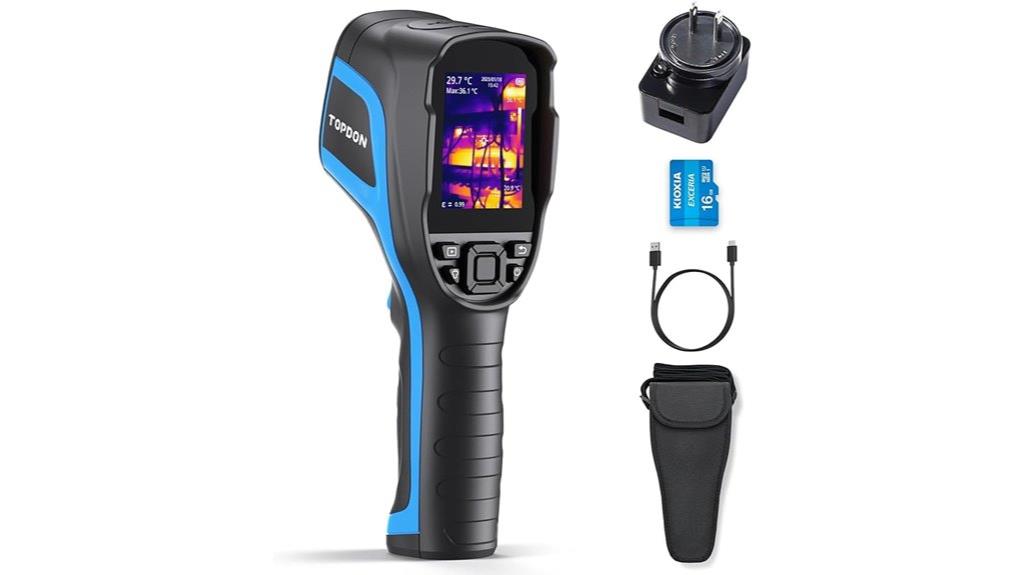
The TOPDON TC004 Thermal Imaging Camera stands out as an excellent choice for professionals who need detailed, high-resolution thermal imaging on the go. It features a 256×192 IR resolution, thermal sensitivity below 40mk, and a temperature range from -4°F to 662°F. With multiple color palettes, auto/manual focus, and a built-in LED flashlight, it’s versatile for various inspections. The device supports video recording, live PC display, and real-time detection, all powered by a rechargeable 5000mAh battery that lasts up to 12 hours. Compact and rugged, it’s perfect for diagnosing issues in industrial, automotive, or home environments with ease and precision.
Best For: professionals and technicians seeking a portable, high-resolution thermal imaging device for detailed inspections in industrial, automotive, home, or educational settings.
Pros:
- High 256×192 IR resolution with excellent thermal sensitivity (<40mk) for detailed imaging
- Long-lasting 12-hour rechargeable battery and durable, ergonomic design suitable for rugged environments
- Multiple color palettes, auto/manual focus, and built-in LED flashlight enhance usability and versatility
Cons:
- Software download requires RAR files and WINZIP, which may incur additional costs or complexity
- Lack of onboard emissivity reference guides and limited manual explanations for some settings
- Occasional lag during post-processing and file management could affect workflow efficiency
H128 Handheld Thermal Camera with 240 x 240 Resolution
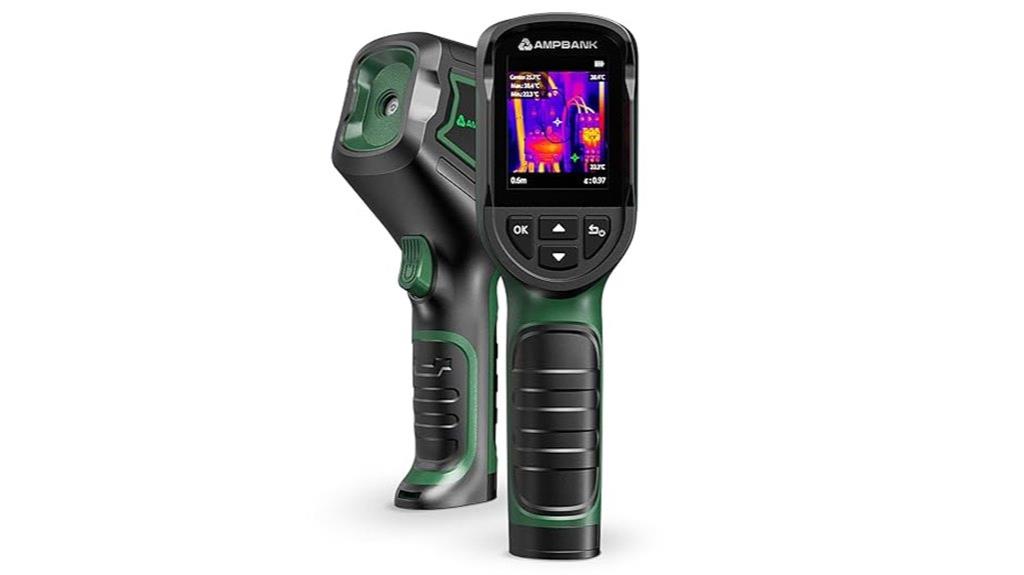
The H128 Handheld Thermal Camera stands out for its high-resolution 240×240 imaging, making it an excellent choice for professionals and serious hobbyists inspecting electrical panels, battery systems, and other heat-sensitive components. It offers enhanced clarity with a 240×240 TISR resolution and a thermal sensitivity of 40mk, allowing detection of tiny temperature differences. The device features a 25Hz frame rate and a 240×240 display, providing detailed images. With multiple color palettes, precise temperature measurement within ±3%, and built-in alarms, it guarantees accurate, real-time diagnostics. Its durable, ergonomic design with long battery life makes it versatile for various inspection environments.
Best For: professionals and serious hobbyists seeking high-resolution thermal imaging for detailed inspections of electrical, HVAC, and insulation systems.
Pros:
- High-resolution 240×240 thermal imaging for clear, detailed images
- Precise temperature measurement with ±3% accuracy and adjustable settings
- Durable, ergonomic design with a long-lasting rechargeable battery
Cons:
- Slightly blocky images due to combined IR sensor and TISR resolution
- Small display size and 25Hz refresh rate may cause some lag and limited viewing comfort
- No included power adapter, requiring a separate purchase for charging
HF96 Thermal Camera with 240×240 Resolution
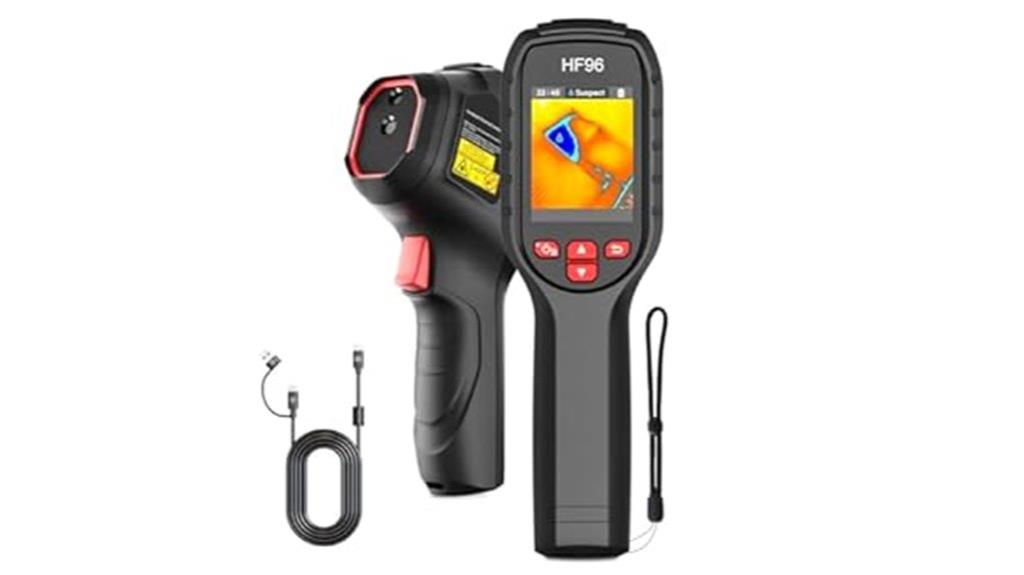
With its impressive 240×240 thermal resolution, the HF96 Thermal Camera delivers detailed heatmaps that are essential for accurately inspecting battery packs and electrical systems. Its intelligent scene recognition with IntellFault technology automates detection of water leaks, insulation gaps, electrical faults, and moisture issues, saving time and increasing accuracy. The device combines a thermal camera, thermometer, and laser pointer into a single, user-friendly tool. It supports real-time heatmap visualization, super resolution enhancement, and multiple color palettes. With a wide 50° field of view, manual adjustments, and durable IP54 housing, the HF96 is reliable and versatile for various inspection scenarios.
Best For: DIY homeowners, electrical technicians, and HVAC professionals seeking an affordable, high-resolution thermal imaging tool for broad-area heat mapping and troubleshooting.
Pros:
- High-resolution 240×240 thermal images provide detailed heatmaps for accurate inspections
- Intelligent scene recognition with IntellFault technology automates detection of common issues
- Long battery life (up to 11 hours) and durable IP54 housing ensure reliable, all-day use in various environments
Cons:
- Limited resolution (96×96 IR resolution) may struggle with pinpointing very small hotspots
- Slow image refresh rate can affect real-time monitoring during dynamic inspections
- Slightly bulky for tight spaces and some users report minor difficulty in identifying small anomalies
TOPDON TC004 Mini Thermal Imaging Camera
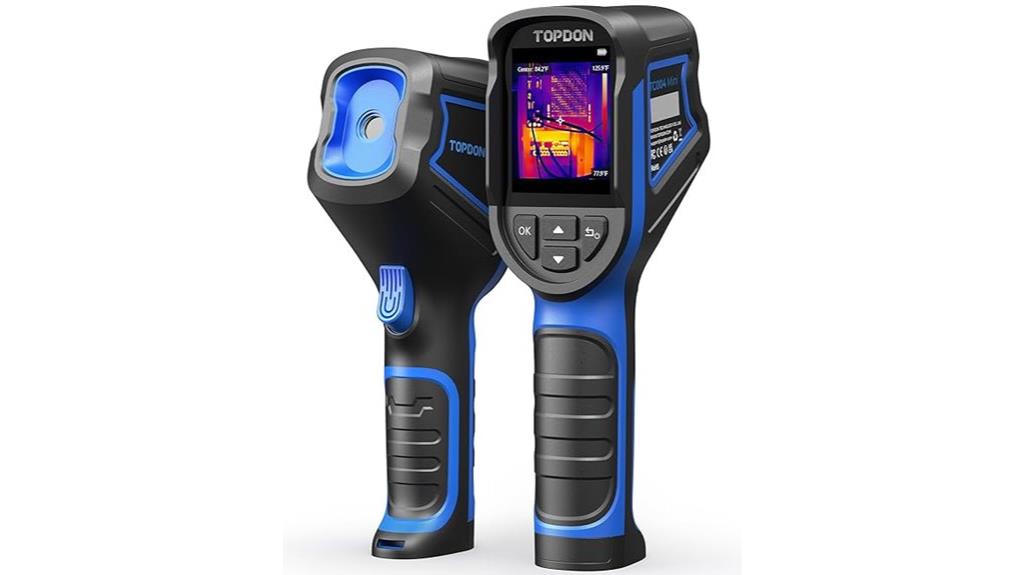
If you’re looking for a compact and reliable thermal camera that delivers high-resolution images, the TOPDON TC004 Mini is an excellent choice. It features a 128×128 IR resolution, upscaled to 240×240 with TISR technology, ensuring detailed thermal images. With a 25Hz refresh rate and a 40°x30° field of view, it captures temperatures from -4°F to 842°F (-20°C to 450°C). The device offers five color palettes for customization and automatically detects temperature extremes, aiding precise diagnostics. Its lightweight, durable design supports outdoor use, while up to 15 hours of battery life and built-in photo storage make it versatile and practical for various inspection tasks.
Best For: DIY enthusiasts and professionals seeking a compact, high-resolution thermal camera for home inspections, automotive diagnostics, and electrical troubleshooting.
Pros:
- Excellent image clarity with 128×128 IR resolution upscaled to 240×240 using TISR technology for detailed thermal images
- Long battery life of up to 15 hours supports extended inspection sessions
- Durable, lightweight design with an IP54 waterproof rating suitable for outdoor and industrial environments
Cons:
- Does not include a power adapter in the package, only a charging cable
- Limited to 512MB of storage, which may fill up quickly with frequent photo capture
- No built-in adjustable focus, relying on fixed lens for thermal imaging
FLIR ONE Gen 3 Thermal Imaging Camera for Android Smartphones
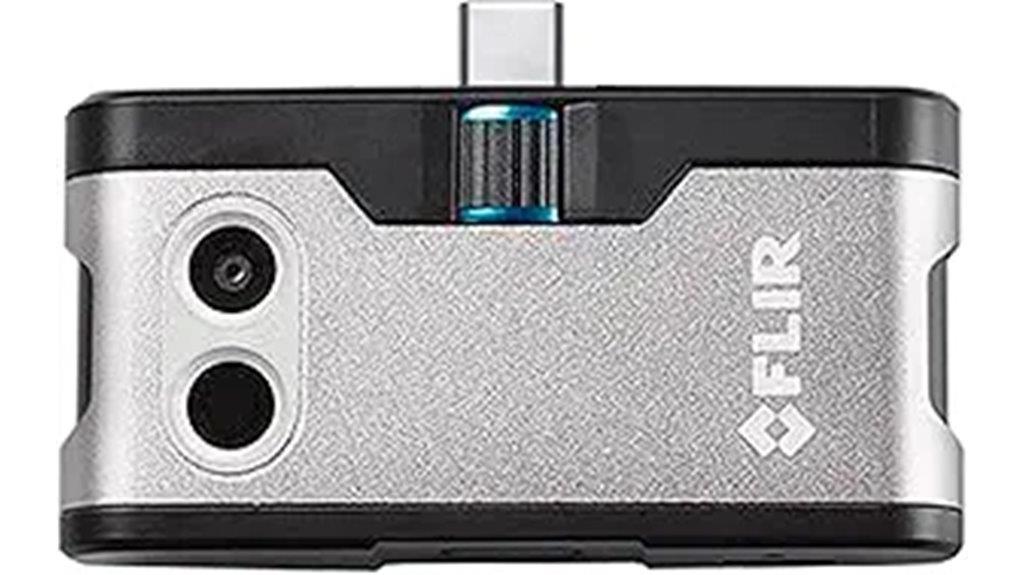
For Android users seeking a portable and affordable thermal imaging solution, the FLIR ONE Gen 3 stands out as an excellent choice, especially for home inspectors, DIY enthusiasts, and hobbyists. It plugs directly into your phone’s USB-C port, with an adjustable connector to accommodate cases. Despite its compact size and light weight, it delivers high-resolution infrared images at 1440×1080 and thermal resolution at 80×60. The device features MSX image enhancement, automatic calibration, and a temperature range from -4°F to 248°F. Built tough with a drop rating of 1.5 meters, it’s perfect for quick, on-the-spot inspections of heat leaks, electrical faults, and moisture issues.
Best For: DIY enthusiasts, home inspectors, and hobbyists seeking an affordable, portable thermal imaging solution compatible with Android smartphones.
Pros:
- High-resolution infrared images at 1440×1080 for clear thermal visualization
- Compact, lightweight design with durable construction rated for drops from 1.5 meters
- Easy plug-and-play operation with adjustable USB-C connector for phones with cases
Cons:
- Lower thermal resolution (80×60) compared to higher-end models, limiting detail
- Potential strain on phone’s USB-C port during extended use or heavy-duty applications
- Frame rate of 9Hz may not be ideal for detecting fast-changing thermal scenes
HIKMICRO B01 Thermal Camera with IR Resolution
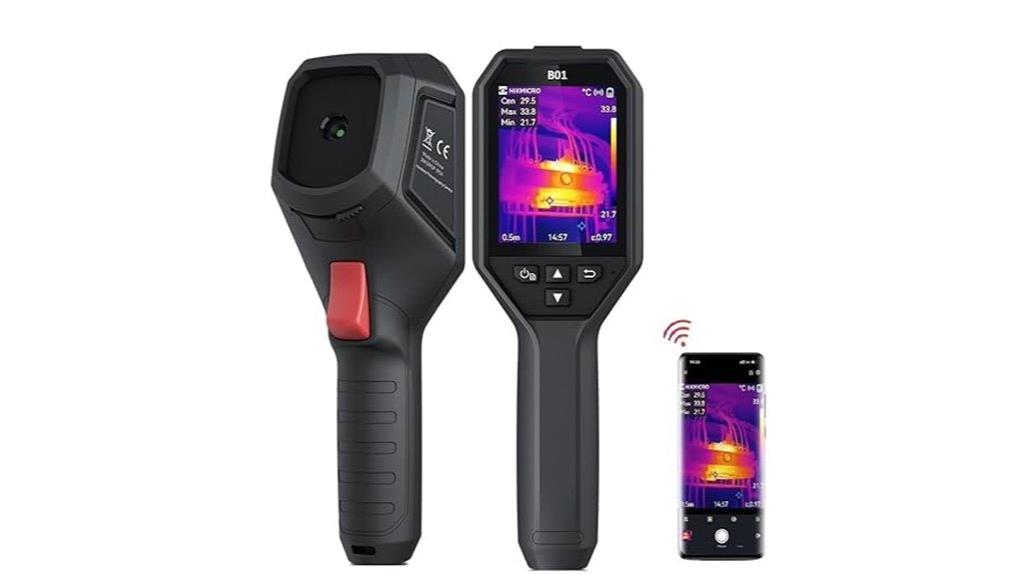
The HIKMICRO B01 Thermal Camera stands out for its high-resolution IR sensor, featuring 256×192 pixels that are upscaled to 320×240 for sharper images. With thermal sensitivity below 40mK and an accuracy of ±2°C or ±2%, it delivers precise thermal readings across a range of -4°F to 1022°F (-20°C to 550°C). Its fast 25Hz refresh rate ensures real-time responsiveness, while the 3.2-inch LCD provides clear visuals. The camera supports WiFi streaming, live editing via the HIKMICRO Viewer App, and offers up to 6 hours of battery life. It’s ideal for detecting hotspots, leaks, and electrical faults efficiently.
Best For: professionals in HVAC, electrical, plumbing, or building inspections seeking high-resolution thermal imaging for accurate fault detection.
Pros:
- High IR resolution with SuperIR enhancement for detailed images
- Fast 25Hz refresh rate allows real-time thermal analysis
- Long battery life supporting up to 6 hours of continuous use
Cons:
- Connecting to PCs as a webcam can be challenging and may freeze on some systems
- Slight noise in thermal images compared to higher-end models
- Learning curve for app-based controls and menu system for new users
TOPDON TC004 Thermal Imaging Camera
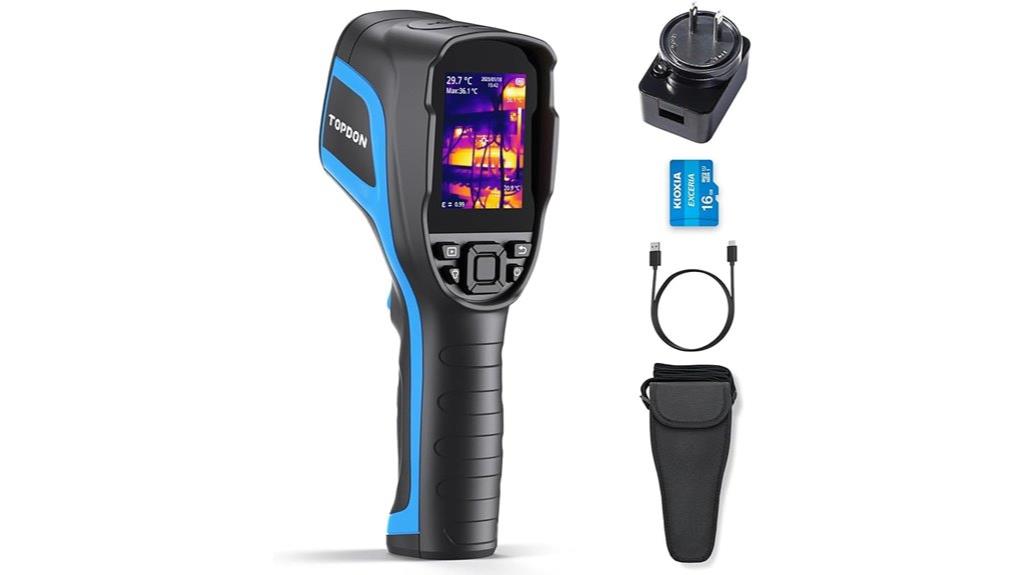
The TOPDON TC004 Thermal Imaging Camera stands out with its high-resolution 256×192 infrared sensor, making it ideal for professionals who need detailed, accurate thermal images. It offers a thermal sensitivity under 40 millikelvin and a temperature range from -4°F to 662°F, with three measurement modes: center point, max, and min. Features like auto/manual focus, multiple color palettes, and an LED work light enhance usability. Its portability, long 12-hour battery life, and IP54 durability make it suitable for various environments. Plus, video recording and real-time PC streaming support thorough analysis, making it a versatile tool for diagnosing issues before they escalate.
Best For: professionals and technicians who require detailed, accurate thermal imaging for industrial, automotive, home inspection, or educational applications.
Pros:
- High-resolution 256×192 IR sensor provides clear and detailed thermal images
- Long-lasting 12-hour battery life supports extended work sessions
- Durable design with IP54 rating and drop resistance suitable for rugged environments
Cons:
- Software download involves RAR files and paid WINZIP license, which may add ongoing costs
- Lack of embedded emissivity reference guides in the manual or device
- Some users experience laggy image display during post-processing or file management
Handheld Thermal Camera with 512×384 Resolution
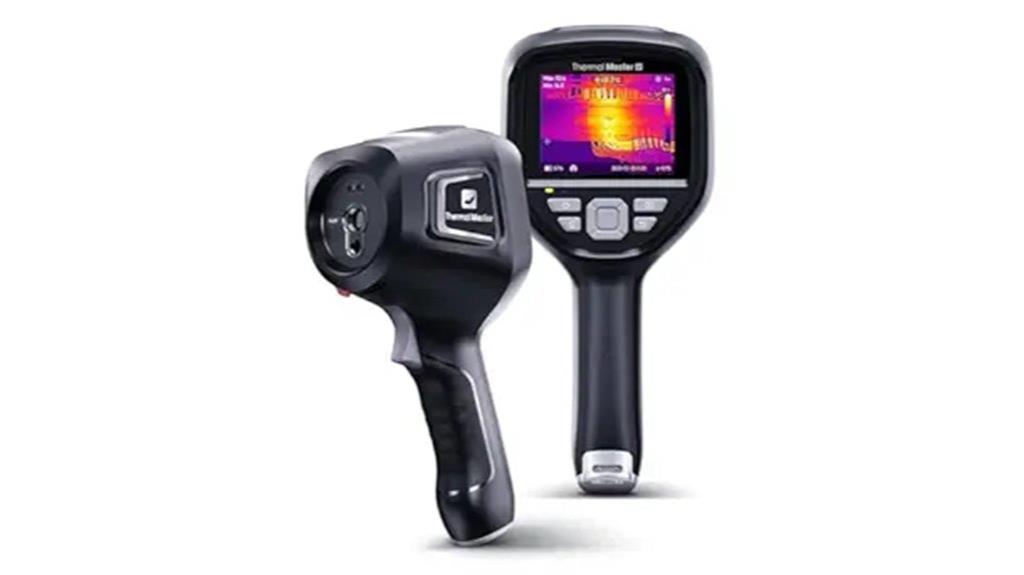
If you need a thermal camera capable of capturing highly detailed images, the handheld model with 512×384 resolution is an excellent choice. Its upgraded X³ IR technology delivers sharp thermal images with minimal lag, supported by a bright 3.5-inch IPS display. It offers versatile modes like Picture-in-Picture and fusion overlay, blending thermal and visual data for better analysis. The device supports wide temperature ranges and precise measurements, with multiple points and emissivity adjustments. Rugged and long-lasting, it’s equipped with features like laser pointer, flashlight, and WiFi for easy data transfer. Perfect for detailed inspections in electrical, HVAC, or mechanical work.
Best For: professionals and enthusiasts needing high-resolution thermal imaging for detailed inspections in electrical, HVAC, mechanical, and building diagnostics.
Pros:
- Ultra-high 512×384 IR resolution delivers sharp, detailed thermal images.
- Versatile modes like Picture-in-Picture and fusion overlay enhance image interpretation.
- Rugged construction with long battery life and easy wireless data transfer.
Cons:
- Lacks a macro lens for close-up inspections of small components.
- No weather-sealing, which may limit outdoor use in harsh conditions.
- The interface could benefit from additional features like button hold for easier scrolling.
TOPDON TC005 Thermal Imaging Camera with Dual Cameras and 12-Hour Battery
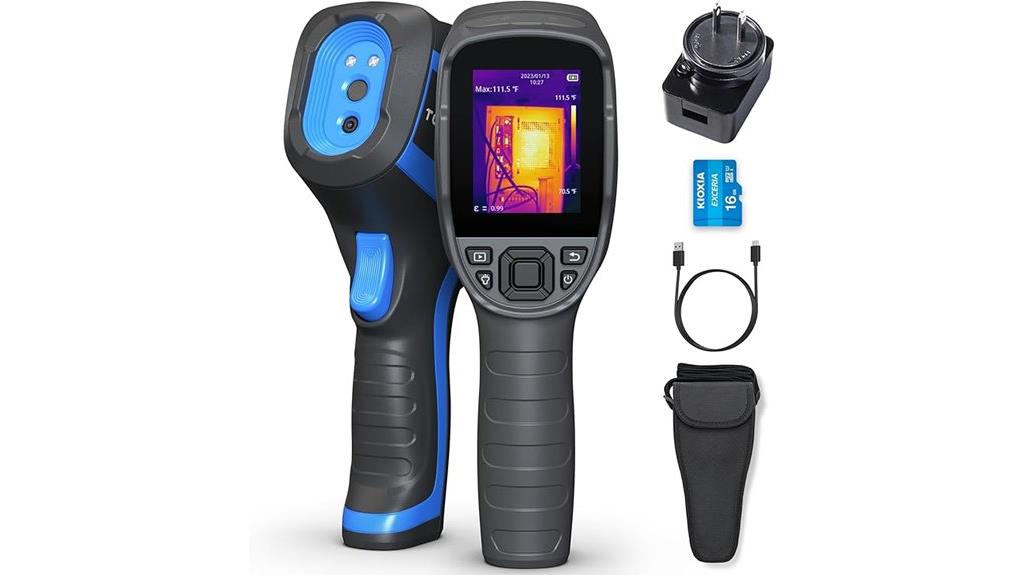
For professionals seeking a reliable thermal camera with extended battery life, the TOPDON TC005 stands out thanks to its impressive 12-hour runtime, ensuring it can handle long inspection sessions without frequent recharging. This device features dual cameras—a thermal sensor with 256×192 resolution and a visible light camera—allowing versatile imaging modes like thermal, dual-light, and picture-in-picture. It supports temperature ranges from -4°F to 1022°F and offers automatic hot/cold spot tracking. Built for durability with IP54 rating and drop resistance, it’s perfect for inspecting batteries, electronics, and buildings. Its long-lasting battery and user-friendly interface make it a dependable tool for demanding fieldwork.
Best For: professionals and technicians who need a durable, long-lasting thermal imaging tool for extended inspection sessions in fields like electronics, building inspection, and outdoor work.
Pros:
- Up to 12 hours of battery life for prolonged use without frequent recharging
- Versatile dual-camera system with clear thermal and visible imaging modes
- Rugged, IP54-rated construction with drop resistance suitable for demanding environments
Cons:
- Slight tendency for temperature readings to be marginally higher than actual values
- Image overlay alignment issues in certain modes like iMIX, requiring post-processing adjustments
- Larger and heavier than typical handheld thermal cameras, potentially affecting portability
TOPDON TC002C Duo Thermal Camera for USB-C Devices
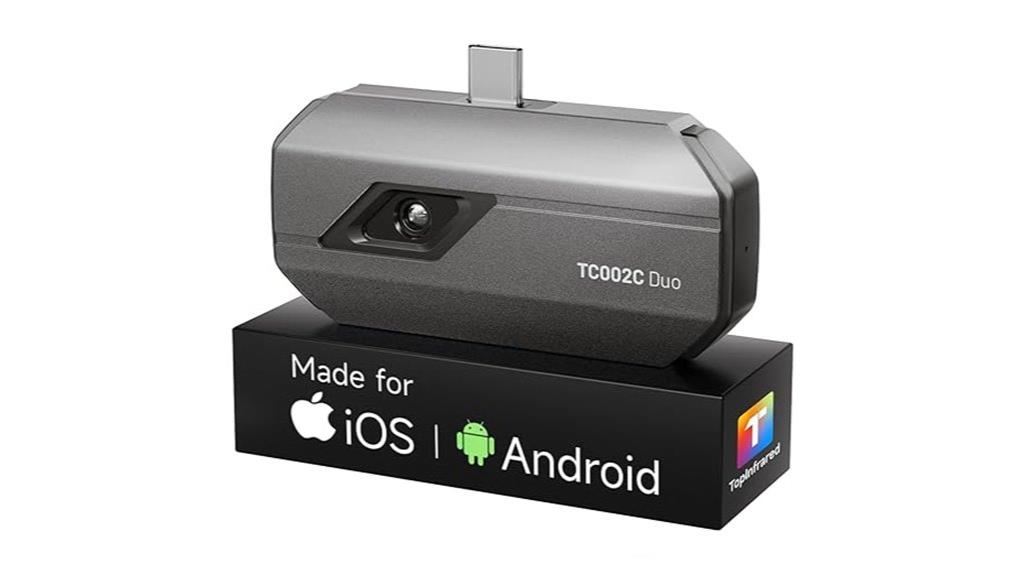
Designed for tech-savvy professionals and DIY enthusiasts alike, the TOPDON TC002C Duo Thermal Camera excels in providing high-resolution thermal imaging directly from your USB-C device. Its universal compatibility works with all smartphones and tablets, including iOS, Android, and Windows, with a handy USB-C to Lightning cable for iPhone users. The compact, lightweight design makes it easy to carry and operate single-handedly. Using the TopInfrared app, you get seamless control and real-time heat detection with a sharp resolution of 256×192 upscaled to 512×384. With a temperature range from -4°F to 1022°F, it’s perfect for diagnostics, home inspections, and automotive troubleshooting on the go.
Best For: DIY enthusiasts, home inspectors, and automotive technicians seeking portable, high-resolution thermal imaging compatible with their smartphones or tablets.
Pros:
- Universal USB-C compatibility with iOS, Android, and Windows devices.
- Compact and lightweight design for easy portability and one-handed operation.
- High-resolution thermal imaging with real-time heat detection and adjustable temperature ranges.
Cons:
- Some features, such as saving images, require a paid subscription.
- Not compatible with Mac devices.
- App may include ads and requires a workaround for some functionalities.
HP96 Thermal Imaging Camera with Visual Camera and Touch Screen

The HP96 Thermal Imaging Camera stands out for its live super resolution technology, transforming thermal images from 96×96 to 240×240 in real-time. This enhancement delivers clearer, high-definition details, making it easier to identify issues like insulation gaps or water leaks. Equipped with both a thermal and a visual camera, it offers versatile imaging modes—thermal, visual, fusion, PIP, and blending—and eight color palettes for different detection needs. The 3.5-inch touchscreen makes adjustments simple, while features like temperature alarms and scene recognition automate problem detection. With a robust build, long battery life, and ample storage, the HP96 is well-suited for quick, accurate inspections.
Best For: DIY homeowners and contractors seeking an affordable, easy-to-use thermal imaging tool for detecting leaks, insulation issues, and other thermal anomalies.
Pros:
- Intuitive 3.5-inch touchscreen with simple adjustments and user-friendly interface
- Real-time super resolution enhances image clarity for better issue identification
- Long battery life and ample storage support extended use in various environments
Cons:
- Modest resolution and sensor sensitivity may limit detection of small thermal differences
- Occasional calibration delays and interface quirks can affect workflow
- Some units experience quality control issues, such as faulty batteries or inconsistent performance
FLIR C5 Compact Thermal Imaging Camera

The FLIR C5 Compact Thermal Imaging Camera stands out as a versatile choice for both professionals and DIY enthusiasts seeking reliable thermal inspection. Its lightweight, portable design makes it easy to handle during electrical, mechanical, building, and HVAC inspections. With a temperature range from -20°C to 400°C and a 160×120 thermal sensor, it captures detailed images enhanced by MSX® technology. The built-in visual camera, LED flashlight, and Wi-Fi support for cloud sharing streamline troubleshooting and reporting. Despite some limitations like lower resolution and slower refresh rates, its durability, ease of use, and practical features make it a solid option for detecting hidden faults efficiently.
Best For: DIY homeowners, electrical and HVAC professionals, and wildlife enthusiasts seeking a portable, easy-to-use thermal imaging solution for diagnostics and inspections.
Pros:
- Compact, lightweight design for easy handling and portability
- User-friendly interface with features like automatic temperature scaling and photo editing
- Wi-Fi connectivity for quick image sharing and cloud storage
Cons:
- Lower sensor resolution and slower refresh rates may limit detailed analysis
- Occasional reports of device overheating or intermittent operation over time
- Restricted by U.S. export regulations, limiting use in certain military or weapons-related applications
KAIWEETS KTI-200 Thermal Camera
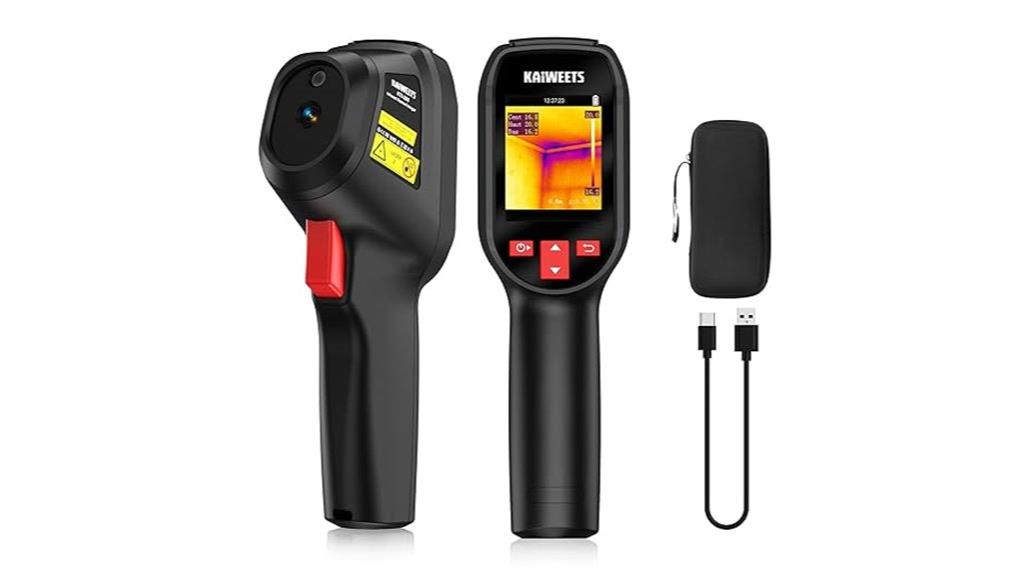
If you’re looking for a thermal camera that combines high-resolution imaging with precise temperature measurement, the KAIWEETS KTI-200 stands out as an excellent choice. It offers a 240×240 IR resolution and a 25Hz refresh rate, providing smooth, clear thermal images on its 2.4-inch LCD screen. With a 50° field of view, it captures large areas with detail. It measures temperatures from -4°F to 1022°F with ±2% accuracy, and its built-in laser pointer helps target objects accurately. Plus, with 15 color palettes, auto tracking, spot detection, and up to 8 hours of battery life, it’s ideal for thorough inspections.
Best For: professionals and technicians seeking high-resolution thermal imaging with precise temperature measurement for building inspections, electrical diagnostics, or mechanical maintenance.
Pros:
- High IR resolution of 240×240 provides clear, detailed thermal images
- Accurate temperature measurement from -4°F to 1022°F with ±2% precision
- Long battery life of up to 8 hours supports extended inspection tasks
Cons:
- Relatively small 2.4-inch LCD screen may limit detailed viewing for some users
- No integrated Wi-Fi or wireless connectivity options for real-time sharing
- May be heavier or bulkier compared to handheld models with fewer features
ERICKHILL ETI-01 Thermal Camera with Infrared Thermometer
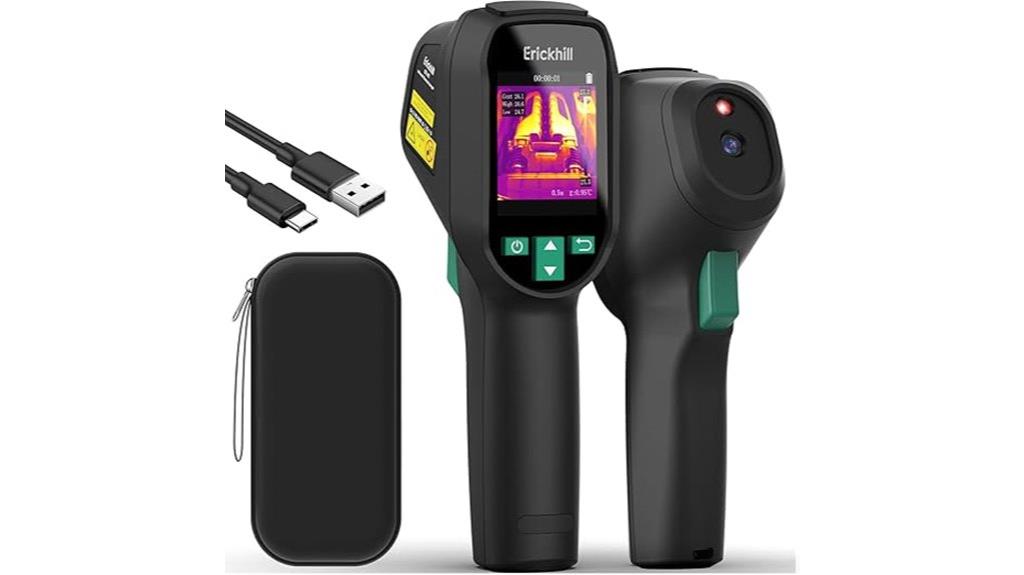
For professionals seeking precise thermal imaging combined with quick temperature measurements, the ERICKHILL ETI-01 Thermal Camera with Infrared Thermometer stands out. It offers over 30,000 radiometric images, multiple color palettes, and advanced SuperIR technology that enhances resolution from 96×96 to 240×240 pixels. With a temperature range from -20°C to 550°C and ±2°C accuracy, it’s ideal for detecting hidden issues like leaks, electrical hotspots, or HVAC problems. Its compact design, built-in laser pointer, 8-hour battery life, and intuitive interface make it suitable for on-the-go inspections across various industries. Priced around £180, it combines reliability and versatility for proactive maintenance.
Best For: professionals and DIY enthusiasts needing accurate thermal imaging and quick temperature readings for diagnostics, maintenance, and safety inspections.
Pros:
- High-resolution thermal images with upscaled SuperIR technology for detailed diagnostics
- Long battery life of approximately 8 hours suitable for extended use in the field
- User-friendly interface with intuitive controls, laser pointer, and versatile color palettes
Cons:
- Higher price point around £180 may be a barrier for casual users
- Non-user-replaceable battery requires charging via USB-C, which may be inconvenient if battery wears out
- Limited to a maximum temperature of 550°C, which might not suit very high-temperature industrial applications
Factors to Consider When Choosing a Thermal Camera for Battery Inspection
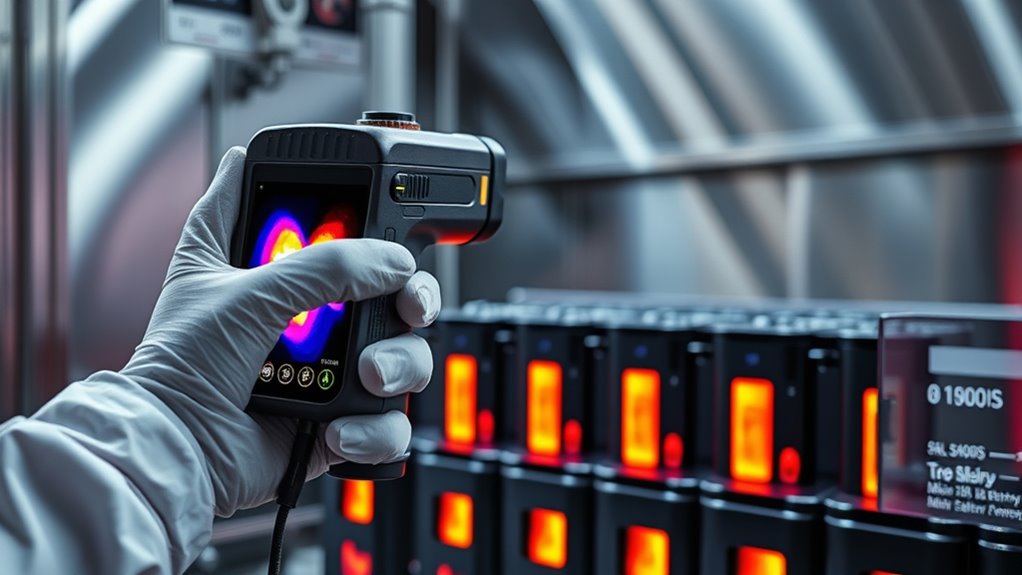
When selecting a thermal camera for battery inspection, I consider several key factors to ensure reliable results. These include the camera’s temperature range, resolution, and sensitivity, which directly impact accuracy and image clarity. Additionally, features like emissivity adjustment and battery life play an essential role in making an informed choice.
Temperature Range Coverage
Choosing a thermal camera with the right temperature range is vital for effective battery inspection. Batteries operate within a temperature span from -20°C to 550°C, so your camera must cover this entire spectrum to detect both cold and hot anomalies accurately. A wider temperature range helps identify overheating issues early, preventing damage or failure. Cameras with limited coverage might miss critical thermal events, especially in high-capacity or industrial batteries that run hotter. It’s also important to guarantee the camera’s accuracy within its specified range, providing reliable readings across all temperatures. Additionally, adjustable emissivity settings are beneficial for surfaces with different thermal properties, ensuring precise measurements regardless of casing material. Selecting a camera with proper temperature coverage is indispensable for thorough and effective battery inspections.
Resolution and Image Clarity
Selecting a thermal camera with high resolution and excellent image clarity substantially improves the accuracy of battery inspections. Cameras with resolutions of 240×240 or higher capture more detailed images, making it easier to spot small or subtle temperature differences. Image clarity depends on the thermal sensor’s sensitivity, with lower mK values enabling detection of minute temperature variations critical for diagnosing battery issues. Super resolution technology can upscale lower-resolution images in real-time, enhancing detail and helping identify hotspots or cold spots more precisely. High-quality visuals also ensure temperature readings are accurate, reducing interpretation errors during inspections. Overall, superior resolution and clarity are essential for early detection of potential failures, such as thermal runaway or internal faults, before they cause significant damage or safety hazards.
Emissivity Adjustment Options
Adjustable emissivity settings are essential because they let you calibrate the thermal camera for accurate readings across different materials involved in battery inspections. Many cameras offer manual adjustments or pre-set options tailored to common materials like metals, plastics, and ceramics, ensuring precise measurements. Proper emissivity calibration is crucial because shiny metals and reflective surfaces tend to reflect infrared radiation, which can distort temperature readings if not set correctly. Failing to adjust emissivity can lead to errors of several degrees, risking misdiagnosis of potential issues. Some advanced models include automatic emissivity detection or reference guides to help users quickly and accurately set the right values. These features are vital for reliable inspections, especially when dealing with complex surfaces and diverse materials.
Battery Life Duration
Battery life duration plays a significant role in guaranteeing that thermal cameras can perform exhaustive inspections without interruptions. When inspecting batteries, especially in the field, you need a device that can operate continuously for hours. Many thermal cameras designed for this purpose offer at least 8 to 12 hours of battery life on a single charge, supporting extended diagnostic sessions. Rechargeable batteries with USB-C or similar fast-charging options help minimize downtime by allowing quick recharges between uses. Keep in mind that environmental factors like extreme temperatures can drain the battery faster, so choosing a camera with ample battery capacity is vital. Matching the camera’s battery life to your inspection requirements ensures reliable results and prevents disruptions during critical battery assessments.
Detection Sensitivity Level
Detection sensitivity level is a critical factor when choosing a thermal camera for battery inspection because it determines how well the device can distinguish small temperature differences. A lower sensitivity value, measured in millikelvin (mK), means higher sensitivity, allowing the camera to detect subtle variations in heat. For battery inspections, a sensitivity below 50mK is ideal, as it helps identify minor issues like internal resistance or early overheating. Higher sensitivity improves the camera’s ability to spot thermal anomalies before they cause damage or failure. Accurate temperature readings, especially in small or localized heat sources, depend heavily on this feature. I recommend selecting a camera with a sensitivity of 40mK or lower for the most precise detection of thermal irregularities, ensuring better maintenance and safety.
Ease of Use Features
When selecting a thermal camera for battery inspections, ease of use is a crucial factor that can markedly impact your efficiency and accuracy. An intuitive interface with straightforward navigation and clear controls minimizes the learning curve, letting you operate confidently even if you’re new to thermal imaging. Features like automatic data recording, simple image capture, and easy menu adjustments streamline setup and reduce inspection time. A large, high-resolution display makes thermal data easier to interpret, revealing subtle temperature differences clearly. Built-in targeting aids such as laser pointers and crosshairs improve measurement precision and aim. Additionally, ergonomic design, lightweight construction, and long battery life support comfortable use during extended sessions and in challenging environments, ensuring you stay effective throughout your inspections.
Software Compatibility & Support
Choosing a thermal camera with compatible software is essential to guarantee smooth data transfer and analysis during battery inspections. Make sure the software works seamlessly with your operating system, whether it’s Windows, Mac, Android, or iOS, to avoid compatibility issues. Look for devices that offer dedicated apps or software supporting real-time monitoring, image capture, and detailed reporting, which streamline your inspection process. Confirm that the software receives regular updates and firmware upgrades, ensuring improved functionality and compatibility with new systems. Features like emissivity adjustment, temperature calibration, and anomaly detection tailored for electrical components are valuable. Additionally, reliable customer support, tutorials, and troubleshooting resources are critical for resolving software-related issues quickly, keeping your inspections efficient and accurate.
Durability & Portability
Durability and portability are critical factors in selecting a thermal camera for battery inspections, especially in demanding environments. A sturdy camera should have a high IP rating, like IP54 or higher, to resist dust and water exposure. Drop resistance is also essential; look for models that can survive drops from at least 2 meters. Portability matters too—compact, lightweight designs under 1.5 pounds make handheld inspections easier, especially in tight or hard-to-reach areas. Long battery life, ideally 8 to 12 hours, reduces interruptions during extended tasks. Built-in rugged features such as reinforced casings, shockproof materials, and ergonomic grips enhance durability and ease of transport. Prioritizing these aspects ensures your thermal camera withstands tough conditions while remaining easy to carry and operate.
Frequently Asked Questions
What Is the Optimal Temperature Range for Battery Thermal Inspections?
The ideal temperature range for battery thermal inspections is typically between -20°C and 60°C (-4°F to 140°F). I focus on quickly identifying areas that exceed 45°C (113°F), as these hotspots often indicate potential issues like overheating or internal faults. Maintaining this range helps me catch problems early, ensuring safety and preventing failures. Always consider the specific battery type and manufacturer guidelines for precise temperature thresholds.
How Does Thermal Camera Resolution Impact Defect Detection Accuracy?
Think of thermal camera resolution as the lens through which I see hidden cracks in a gemstone. Higher resolution sharpens the image, revealing subtle temperature differences that could signal defects. This precision allows me to detect tiny anomalies in batteries, preventing failures. Low resolution is like looking through a frosted glass—it obscures details and risks missing critical issues. So, better resolution truly enhances defect detection accuracy.
Can Thermal Cameras Detect Internal Battery Faults or Only Surface Issues?
Thermal cameras primarily detect surface temperature variations, so they’re great for spotting external issues like overheating or uneven temperature distribution. However, they can’t directly see internal battery faults like cell imbalances or internal shorts. Still, if these internal issues cause surface heating or hot spots, thermal cameras can help identify those problems indirectly. So, while they’re excellent for surface inspection, internal faults often require other diagnostic tools.
What Maintenance Is Required to Keep Thermal Cameras Calibrated?
To keep my thermal cameras calibrated, I regularly perform calibration checks using a blackbody reference, which helps guarantee accurate temperature readings. I also follow the manufacturer’s guidelines for calibration intervals, typically recalibrating every 6 to 12 months or after any impact or exposure to extreme conditions. Additionally, I keep the lens clean and store the camera in a controlled environment to sustain peak performance.
Are There Specific Safety Precautions When Using Thermal Cameras Near Batteries?
Yes, I always wear appropriate personal protective equipment, like gloves and safety glasses, when using thermal cameras near batteries. I make certain of proper ventilation to avoid any buildup of gases, and I keep a safe distance to prevent contact with potential leaks. I also follow manufacturer guidelines for both the camera and the batteries, and I avoid pointing the camera directly at live electrical parts to prevent sparks or damage.
Conclusion
Choosing the right thermal camera is like finding the perfect pair of glasses—you want clarity before problems become visible. I once caught a tiny hotspot on a battery before it led to a costly failure, thanks to my thermal camera. Remember, investing in quality now can save you from bigger issues later. So, pick the right tool, and you’ll always stay ahead—seeing problems before they heat up and cause trouble.

